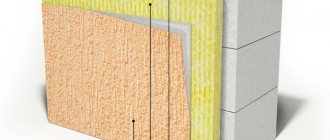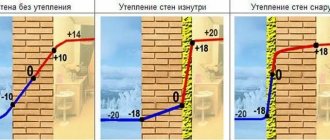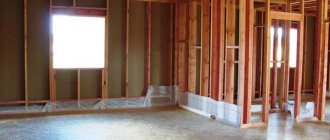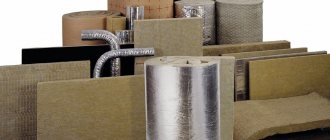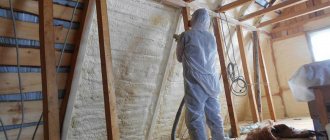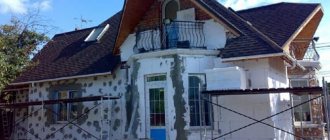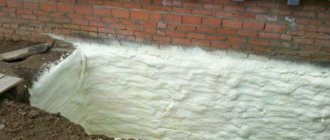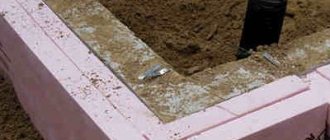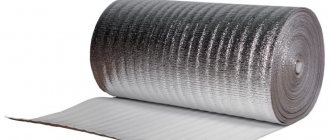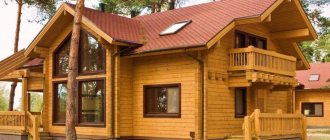The insulation foam used in construction (expanded polystyrene) is plastic foamed in a factory, giving it a certain set of performance properties. According to new regulatory documents, it is marked “PPS”. Suitable for home insulation construction stage and additional insulation old home, for working outside and inside the building. In this case, the material is selected for specific conditions and tasks, and installation work is carried out in strict accordance with the technology.
Types of foam for insulating frames
Foam-based insulation is divided into several types.
They all have similar characteristics, but are fixed to the walls in different ways.
- penoplex
- expanded polystyrene
- penofol
- liquid foam
- foam itself
At the same time, the foam itself differs in density and function: there is foam for walls, and there is for the base and foundation.
Let's look at the difference in foam density. The higher the density, the correspondingly better its thermal insulation characteristics.
The standard density of foam plastic is usually in the range from 10 to 35 kg/m3.
Thus, foam grades are designated PPT 15 (i.e., with a density of about 15 kg/m3), PPT 20, PPT 25 and PPT 35.
Table of characteristics of foam plastic of different brands
Please note that each of these brands differs in price and also has its own scope of application.
For example, PPT 15 is too soft, its density is low, so it cannot be used for floor insulation.
Although the most universal brand PPT 35 can be used everywhere without damaging the foam, its price is higher than the others, so it would be irrational to insulate walls from inside the room - it is too expensive.
The denser the foam, the better it retains its shape, but less dense foam is marginally warmer.
Polystyrene foam consists of polystyrene balls with air
Thus, PPT 15 is used for roof insulation, PPT 25 for insulating walls and vertical surfaces, and PPT 35 for floor insulation.
Production of foam formwork
From hollow foam blocks you can assemble permanent formwork for the foundation of a residential building with your own hands. This saves time and reduces the cost of construction . Also, polystyrene foam formwork serves as an additional thermal insulation layer for the foundation.
Please note: for this type of work, the density of the foam must be higher than 25 kg/m3.
Work begins with standard marking of the site, digging a trench, and laying a sand and gravel cushion for drainage. Then a thin layer of concrete is poured onto it, which, after hardening, will become the basis for the formwork . Along the perimeter of the entire foundation, reinforcement is embedded in concrete. Foam blocks are placed on it, securely connecting them with jumpers. At the next stage, all blocks are leveled horizontally and filled with concrete. The solution is then compacted using deep vibrators . The walls of a residential building can be built in a similar way.
Thus, polystyrene foam is a universal material that is suitable for thermal insulation of the entire house - from the foundation to the roof. However, if you are insulating a large part of the building with it, take care of high-quality supply and exhaust ventilation. This is important for “non-breathable” polystyrene foam.
Insulating a frame house with foam plastic inside
Polystyrene foam is traditionally used to insulate the walls of a frame house, but it is still better to use it to insulate the house from the outside, since the technical smell that foam boards emit disappears from the room in at least a week.
In the first week after insulating the walls inside the house, residents may experience headaches and disturbed sleep.
Insulating the walls of a frame house with foam plastic
What you will need to prepare the walls for insulation:
- hammer drill
- grater
- paint brushes
- bucket or other container for diluting mixtures
- spatulas
- needle roller
- hammer
To fix the foam, you need to make a flat wall surface, for which we remove the old finish.
After cleaning the wall from dirt, dust and other coatings, make sure that when applying the foam sheets there are no recesses or air spaces left.
The foam should fit tightly to the wall. If the quality of the walls leaves much to be desired, it is necessary to prime them. To do this, use a brush or spray.
Using a needle roller, we roughen the surface of the foam board.
Important: we start gluing the insulation from the bottom, for which we install a starting strip. This strip will act as a support for the first sheets of polystyrene foam, and will help to install them evenly.
Using a spatula, apply the adhesive mixture to the insulation, then press it to the surface of the wall and press it with your palm.
You cannot use hard things that will damage the foam - only your palm.
After installing the insulation, check for dents, cracks or damage.
We continue to insulate all the walls in the same way, trying not to leave gaps between the foam sheets.
When the work is finished, it is necessary to use special plastic nails, which experts call mushroom.
This mushroom consists of a plastic circle and a sleeve-leg.
Hammer a nail into the sleeve, which is preferably plastic, this will avoid cold spots.
Mushroom for fixing foam boards to the wall
The fungus is attached thanks to holes made using a puncher.
The length of the holes should be 20 mm greater than the size of the fungus. On average, one sheet of polystyrene foam takes 5 fungi.
Fungi are located at the joints of the slabs, additionally pressing the foam sheets against the wall.
Make sure that the caps are level with the insulation, and after hammering the nails, they are heated by 1.5-2 mm.
If, after insulating the wall, gaps of 5 mm or more remain between the sheets, they must be additionally foamed.
The required foam sizes are easy to cut
Standard length, width and thickness of bricks
Since bricks have their own standard dimensions (6.5 x 12 x 25), the thickness of the brick wall will have several standard dimensions, taking into account the thickness of the seam between adjacent bricks.
There are other sizes, but they mainly differ in height, and the height of the brick does not affect the thickness of the wall.
Standard dimensions of a brick wall
| Number of bricks, pcs | Wall thickness, cm |
| 0,5 | 12 |
| 1 | 25 |
| 1,5 | 38 |
| 2 | 51 |
| 2,5 | 64 |
In addition to the thickness of 65 mm, there are brick thicknesses of 88 mm - one-and-a-half bricks and 138 mm - double bricks. Those. sizes 8.8x12x25 and 13.8x12x25. In general, the thickness (height) of the brick does not in any way affect the thickness of the brickwork.
The main criterion when choosing the thickness of a brick wall is the purpose and location of the wall itself.
Subsequent wall finishing after foam plastic
How to do interior finishing after foam plastic? So, you have glued all the foam sheets to the wall, foamed the joints and waited for them to dry.
Next, you need to cut off the excess foam and check the wall for defects.
If some parts of the insulation stick out, they can be smoothed using a grater. This is especially true for unevenly protruding places in the area of joints.
Use a large spatula and apply the adhesive to the entire wall. Make sure that the glue is applied evenly.
Wall finishing after foam plastic
We glue the plaster mesh to the insulation. Since the glue dries quickly, we cut the mesh in advance to a size of approximately 100x100 cm.
A large mesh may not have time to be securely fixed. After the entire wall is covered with mesh, you can begin to apply the leveling layer.
The layer should be about 3 mm thick; for this we also use a large spatula.
After drying, grouting is performed to remove unevenness.
The next layer is a special primer and a finishing coat. Read about interior decoration methods here.
We cut the mesh at the bottom with a construction knife
Characteristics of various materials
Table 1
The value of the standardized heat transfer resistance of an external wall depends on the region of the Russian Federation in which the building is located.
table 2
The required layer of thermal insulation material is determined based on the following conditions:
- the external enclosing structure of the building is solid ceramic brick of plastic pressing with a thickness of 380 mm;
- interior finishing – plaster with cement-lime composition 20 mm thick;
- external finishing – a layer of polymer-cement plaster, layer thickness 0.8 cm;
- the coefficient of thermal homogeneity of the structure is 0.9;
- thermal conductivity coefficient of insulation - λA=0.040; λB=0.042.
How to insulate the floor of a frame house with foam plastic
Polystyrene foam has long been used for floor insulation, as it consists of millions of small polystyrene beads that retain air inside.
At the same time, it is not afraid of moisture, does not change its properties for a long time, and has a suitable density (PPT 35) to withstand floor loads.
Insulating the floor of a frame house with foam sheets
At the same time, foam insulation is carried out without much effort and knowledge; anyone can do it, even not a professional.
To begin with, as with insulating walls, it is necessary to prepare the surface for the heat-insulating material.
To do this, we clean it, seal cracks, insect passages, crevices, holes through which rodents can enter the house.
Next, we lay a thick film on the floor, which will provide waterproofing. This layer will prevent water from getting inside the insulation.
We lay the film with an overlap, which should be at least 10 cm, and glue the joints of the film with construction tape.
Modern membrane films not only do not allow moisture to pass through, but also have water-repellent properties, while they also return heat to the room.
Floor insulation scheme for a frame house
We lay sheets of foam plastic on the film. It is better to use with profiled edges, which help to avoid cold bridges.
Foam the joints, as the fixation of the slabs must be reliable. If the sheets are not foamed, after a while the sheets will rub their edges against each other and make unpleasant sounds.
Sometimes, to avoid squeaks, it is proposed to deliberately leave a space between the plates of 5 mm, which is then foamed.
We lay another layer of waterproofing on top of the foam, which will help prevent water from penetrating into the floor if something is spilled on the surface.
Floor insulation in a frame house
Next, we lay the metal mesh and do the rough screed.
We apply the cement so as not to damage the film and move the insulation. Its layer should be at least 5 cm. Next, you can make the finishing floor.
If you have a cement screed on the ground in your frame house, is insulation with foam plastic done as follows?
We lay the film on the cement, then use dowels to attach the foam and treat the joints with foam.
You will receive useful information on how to make heated floors in a frame house in our article.
Remember: if there is a basement, it is better to insulate the floor in the house from the basement side. In this case, an additional layer of air is formed, and the floors will be warmer.
If you are insulating without a basement, do not forget that the surface on which the sheets are laid must be prepared.
The screed must be perfectly flat; for this we use a mesh.
We lay the foam sheets tightly on the film and foam the joints
Calculate the thickness of the insulation
Thermal insulation of the outer wall reduces heat loss by two or more times. For a country, most of whose territory belongs to a continental and sharply continental climate with a long period of low negative temperatures, like Russia, thermal insulation of enclosing structures provides a huge economic effect.
Whether the thickness of the heat insulator for external walls is correctly calculated determines the durability of the structure and the microclimate in the room: if the thickness of the heat insulator is insufficient, the dew point is located inside the wall material or on its inner surface, which causes the formation of condensation, high humidity, and then the formation of mold and fungal infection.
The method for calculating the thickness of insulation is prescribed in the Code of Rules “SP 50. 13330. 2012 SNiP 23–02–2003. Thermal protection of buildings."
Factors influencing the calculation:
- Characteristics of the wall material - thickness, design, thermal conductivity, density.
- Climatic characteristics of the building area - the air temperature of the coldest five-day period.
- Characteristics of materials of additional layers (cladding or plaster of the inner surface of the wall).
The insulation layer that meets regulatory requirements is calculated using the formula:
In the “ventilated facade” insulation system, the thermal resistance of the curtain wall material and the ventilated gap is not taken into account in the calculation.
Insulation of a frame house with foam plastic from the outside
Most often, foam boards are used for external insulation of a house.
Since it is not afraid of moisture, it is therefore preferable to use it instead of mineral wool.
As we know, a frame wall consists of several layers, and its last layer is an OSB board.
We insulate a frame house from the outside with polystyrene foam
It is best if the work is carried out in the warm season, since frosts worsen the properties of the glue and the insulation boards will not adhere well.
We attach the foam in the same way as we attached it to the wall. We use dowels after we have glued several sheets. They securely fix the sheets.
And you can be sure that when the adhesive expires, the sheets will not come off.
Insulation of the foundation and basement of a frame house
To insulate the base we use 10 cm polystyrene foam, since the base is the coldest part of the wall.
Using a reinforcing mesh, we treat the base with cement mortar. When the cement is completely dry, you can begin exterior finishing.
The most commonly used material is plaster. If you have chosen lime plaster, you must add cement of at least 400 grade to it.
We process the wall in two layers without intermediate grouting. Read about finishing the façade after insulation here.
Why is it necessary to calculate the thickness of insulation?
Comfortable living in the house involves maintaining optimal indoor temperature, especially in winter. When constructing a building, you should remember about thermal insulation; you should correctly select and calculate the thickness of insulation for the walls, roof, floor and attic. Any material - brick, wood, foam block or mineral wool - has its own value of thermal conductivity and thermal resistance.
A warm home is every owner’s dream
Thermal conductivity is the ability of a material to conduct heat. This value is determined in laboratory conditions, and the obtained data is provided by the manufacturer on the packaging or. Thermal resistance of a material is the reciprocal value of thermal conductivity. A material that conducts heat well has low heat resistance and requires insulation.
When constructing a building, you should remember about high-quality thermal insulation. If mistakes were made in the walls of the house or in other structures during construction, then cold bridges may appear - areas through which heat quickly escapes from the house. In these places, condensation may appear, and subsequently the formation of mold, if insulation measures are not taken during the process.
Insulating the roof of a frame house with foam plastic
Since the roof also needs insulation, foam plastic can be used for it, and PTT 15, the softest and most inexpensive, is suitable.
The fact is that there is almost no load on the roof. However, it should be remembered that stiffer and denser foam will last longer.
Roof insulation with foam plastic sheets
Polystyrene foam is suitable for insulating both sloping and straight roofs.
In addition to the fact that polystyrene foam is not afraid of moisture, does not rot or deteriorate, has high thermal insulation properties, it is lightweight, which is especially important when building a frame house.
At the same time, foam sheets are easily cut and fixed with glue.
They have good soundproofing properties, thanks to which during rain the noise from drops falling on the roof will be minimal.
How is insulation material installed?
We lay a vapor barrier over the insulation
The whole process can be divided into stages:
- Laying waterproofing material on rafters.
- Fastening foam boards between or under rafters.
- Sealing the seams with polyurethane foam to eliminate cold bridges.
- Laying vapor barrier indoors.
- Finishing the interior walls and ceiling of the attic.
The board securely fixes the insulation
Foam plastic slabs are usually laid in the space between the rafters, and the laying should be tight, without cracks.
To adjust the size, the foam is cut using a sharp knife along a ruler and broken along the cut.
The sheets are fixed to the rafters using slats or polystyrene glue. Fastening with glue may not be sufficient, so it makes sense to make a binder from a board.
This design should hold the slabs in several places. The resulting voids between the foam board and other elements are foamed.
Read about how to insulate a frame house with mineral wool in our article here.
Methods for attaching penoplex to the wall, the most optimal method
To install penoplex sheets as insulation for aerated concrete and other types of walls, several fastening methods are used:
- EPS is attached with special glue or mastic;
- Use of special polyurethane foam;
- Fastening penoplex using dowels.
Each option has its own characteristics. Experienced builders use several methods simultaneously to better fix penoplex. For example, the use of glue, and additional fixation on top with dowels.
Finishing work
A prerequisite for completing the work is the installation of a vapor barrier. Polystyrene foam reacts little to moisture; however, the formation of condensation can have a bad effect on the frame and other layers of the structure of a frame house. For vapor barrier, the material used is penofol or its analogues made from foil coverings. In addition, there are new membrane films on the market designed for vapor barrier specifically for frame houses.
Waterproofing is laid as the penultimate layer from bottom to top from the outside of the wall - to protect the thermal insulation, frame, and finish from moisture.
The finishing can be laid directly onto the waterproofing coating. The choice depends on the wishes of the owner of the home - to use siding, facing brick, blackhouse or stone.
